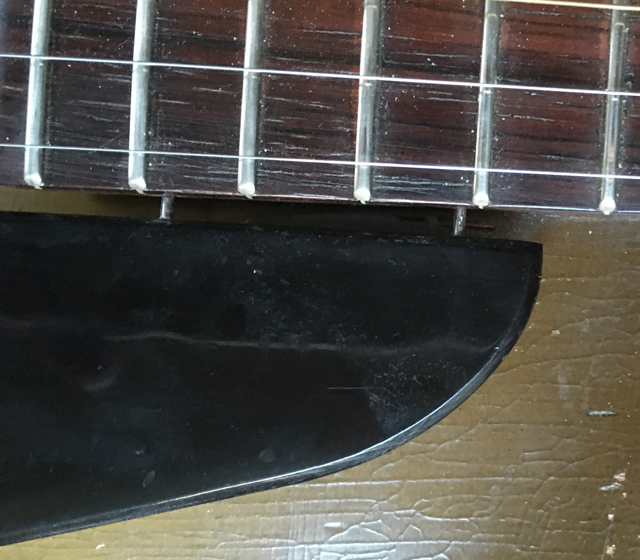
Close-up #38: Pickguard evolution in early Masterbilts 1931–1935
In the first years of Epiphone's Masterbilt model line, design details kept evolving and changing – pickguards included. Although pickguards are among those hardware parts which often got removed or replaced during the lifetime of an instrument, we are now able to trace the history of pickguard design changes – based on the numerous instruments documented in our registry database.
Let's have a look at the earliest Epiphone Masterbilt instruments of the 1931–1935 period – with short pickguards typically made of black pyralin plastic (before the introduction of the larger, tortoise plastic pickguards late 1935): What we found are 5 types of pickguards which are mainly distinguished by details in their different mounting systems. Of particular interest is the fact that each pickguard type was typically used in a certain manufacturing period/SN range. (Note that "cosmetic" varieties within each type such as size, binding or color are ignored for this purpose.)
Type 1: No screw – block and rod (1931)
The earliest Epiphone Masterbilt instruments with original pickguard
show this straight-edged, black plastic unit – without any screw/bolt
visible on the pickguard face: It is attached to the rim via a bracket
with a threaded rod that is fixed to a block glued to the underside of
the guard plate – see photo below.


This earliest "Type 1" pickguard we found on Masterbilt guitars and mandolins in the serial number (SN) range from 5044 to 5308 – instruments likely made in 1931 according to our research. We assume that this pickguard type was used starting with SN 5000. (Note that some of the earliest documented instruments have missing or replaced pickguards).
The tip of the guard plate is attached to the side of the neck/fretboard using two pins – see below. This pin attachment was used on all pickguards until 1934.

Type 2: Two screws (late 1931–mid
1932)
This "Type 2" pickguard is of a similar shape and material as the previous model, however with two screw heads visible on the face of the pickguard – see picture below.


The screws are holding a metal bar fixed to the underside of the
guard, which is attached to a bracket by a bolt. Type 2 has been found
on instruments in the SN range from 5279
to 5641 – we guess
first installed around late 1931, according to our research.
Type 3: One screw (mid 1932–mid 1934)
In 1932, around SN 5681,
we start to see straight-edged pickguards with just one screw for
attachment to a bracket fixed to the rim.



Note that the tip of the guard is still mounted to the neck by two (invisible) pins – no screw head there. These "Type 3" pickguards were standard on guitars until around SN 7582 (1934), on mandolins a bit longer (last SN 8588).
Type 4: Screw at neck, straight shape (mid 1934 – early 1935)
At some point in 1934, pickguard "Type 4" came into use: While sporting one screw through the guard into the rim bracket like the previous Type 3, ...

... there is now also a screw head at the tip of the pickguard – attaching the guard to an angled metal support which is then screwed to the side of the neck (see picture below). Note that the shape of the guard is still straight-edged. This pickguard type is first seen around SN 7613 and lasted until around SN 8312 (plus a few later Sorrentino brand guitars).

By early 1935 the shape of the pickguard was changed to a curved edge towards the rim. This "Type 5" guard was otherwise similar to Type 4, with the same mounting systems. Type 5 appeared first around SN 8320 and was used on all models until late 1935 when elongated, tortoise plastic pickguards were introduced on the higher models with the new 17⅜" body size. The black Type 5 pickguard remained in use on lower-priced guitars until 1939 (last on Olympic SN 15131), when these models switched to a longer, tortoise plastic pickguard, too.

The table below summarizes the pickguard evolution in the early Epiphone Masterbilt series – i.e. the short, black plastic units:
| Year first |
SN first |
Type |
Shape | Mounting to bracket |
to neck |
| mid 1931 | 5044 | 1 | straight | no screw (block+rod) | pins |
| late 1931 | 5279 | 2 | straight | 2 screws | pins |
| mid 1932 | 5681 | 3 | straight | 1 screw | pins |
| mid 1934 | 7613 | 4 | straight | 1 screw | screw |
| early 1935 | 8320 | 5 | curved | 1 screw | screw |
And below the Masterbilt pickguard evolution as shown in Epiphone catalog illustrations. From top to bottom:
- Type 1 Royal – 1932 catalog, p8
- Type 2: Olympic – 1932 catalog, p11
- Type 3: Blackstone – 1932 catalog, p9
- Type 4: Broadway – 1934 catalog, p8
- Type 5: Spartan – 1936 catalog, p7

Note one interesting detail: The 1932 catalog includes instruments showing three different types/generations of pickguards! Why that?
I have my theory – more about that in Close-up stories 39 and 40 ...
(January 26, 2018 – with later updates)